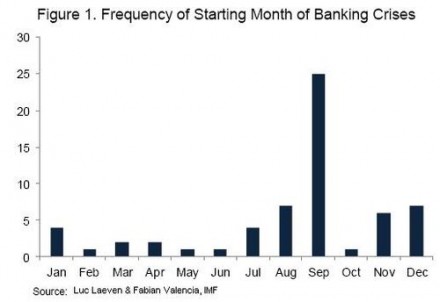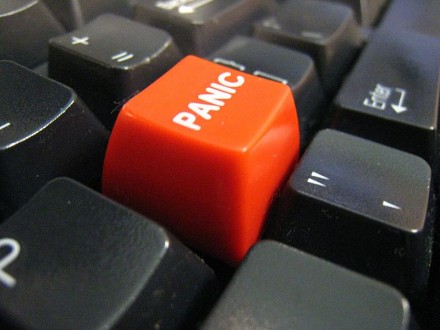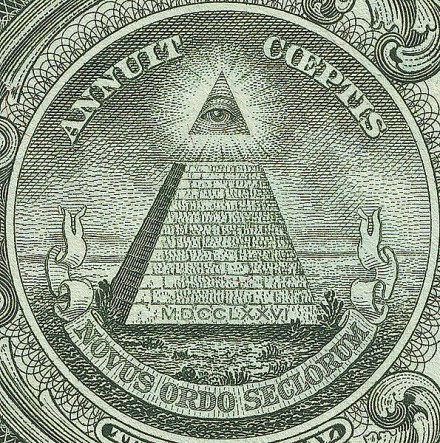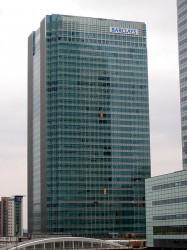 What is the second half of 2012 going to bring? Are things going to get even worse than they are right now? Unfortunately, that appears more likely with each passing day. I will admit that I am extremely concerned about the second half of 2012. Historically, a financial crisis is much more likely to begin in the fall than during any other season of the year. Just think about it. The stock market crash of 1929 happened in the fall. “Black Monday” happened on October 19th, 1987. The financial crisis of 2008 started in the fall. There just seems to be something about the fall that brings out the worst in the financial markets. But of course there is not a stock market crash every year. So are there specific reasons why we should be extremely concerned about what is coming this year? Yes, there are. The ingredients for a “perfect storm” are slowly coming together, and in the months ahead we could very well see the next wave of the economic collapse strike. Sadly, we have never even come close to recovering from the last recession, and this next crisis might end up being even more painful than the last one.
What is the second half of 2012 going to bring? Are things going to get even worse than they are right now? Unfortunately, that appears more likely with each passing day. I will admit that I am extremely concerned about the second half of 2012. Historically, a financial crisis is much more likely to begin in the fall than during any other season of the year. Just think about it. The stock market crash of 1929 happened in the fall. “Black Monday” happened on October 19th, 1987. The financial crisis of 2008 started in the fall. There just seems to be something about the fall that brings out the worst in the financial markets. But of course there is not a stock market crash every year. So are there specific reasons why we should be extremely concerned about what is coming this year? Yes, there are. The ingredients for a “perfect storm” are slowly coming together, and in the months ahead we could very well see the next wave of the economic collapse strike. Sadly, we have never even come close to recovering from the last recession, and this next crisis might end up being even more painful than the last one.
The following are 17 reasons to be extremely concerned about the second half of 2012….
#1 Historical Trends
A recent IMF research paper by Luc Laeven and Fabián Valencia showed that a banking crisis is far more likely to start in September than in any other month. The following chart is from their report….

So what will this September bring?
#2 JP Morgan
Do you remember back in May when JP Morgan announced that it would be taking a 2 billion dollar trading loss on some derivatives trades gone bad? Well, the New York Times is now reporting that the real figure could reach 9 billion dollars, but nobody really knows for sure. At some point is JP Morgan going to need a bailout? If so, what is that going to do to the U.S. financial system?
#3 Derivatives
Last week, Moody’s downgraded the credit ratings of 15 major global banks. As a result, a number of them have been required to post billions of dollars in additional collateral against derivatives exposures….
Citigroup’s two-notch long-term rating downgrade from A3 to Baa2 could have led to US$500m in additional liquidity and funding demands due to derivative triggers and exchange margin requirements, according to the bank’s 10Q regulatory filing at the end of the first quarter.
Morgan Stanley – which Moody’s downgraded from A2 to Baa1 – said a two-notch downgrade from both Moody’s and Standard and Poor’s could spur an additional US$6.8bn of collateral requirements in its latest 10Q. The bank did not break down its potential collateral calls under a scenario where only Moody’s downgraded the bank below the Single A threshold.
Royal Bank of Scotland estimated it may have to post £9bn of collateral as a result of the one-notch Moody’s downgrade to Baa1 in a statement on June 21, but did not detail how much of this additional requirement was driven by margin for swaps exposures.
The worldwide derivatives market is starting to show some cracks, and at some point this is going to become a major disaster.
Remember, the 9 largest U.S. banks have a total of more than 200 trillion dollars of exposure to derivatives. When this bubble completely bursts it is going to be impossible to fix.
#4 LEAP/E2020 Warning
LEAP/E2020 has issued a red alert for the global financial system for this fall. They are warning that the “second half of 2012” will represent a “major inflection point” for the global economic system….
The shock of the autumn 2008 will seem like a small summer storm compared to what will affect planet in several months.
In fact LEAP/E2020 has never seen the chronological convergence of such a series of explosive and so fundamental factors (economy, finances, geopolitical…) since 2006, the start of its work on the global systemic crisis. Logically, in our modest attempt to regularly publish a “crisis weather forecast”, we must therefore give our readers a “Red Alert” because the upcoming events which are readying themselves to shake the world system next September/ October belong to this category.
#5 Increasing Pessimism
One recent survey of corporate executives found that only 20 percent of them expect the global economy to improve over the next 12 months and 48 percent of them expect the global economy to get worse over the next 12 months.
#6 Spain
The Spanish financial system is basically a total nightmare at this point. Moody’s recently downgraded Spanish debt to one level above junk status, and earlier this week Moody’s downgraded the credit ratings of 28 major Spanish banks.
According to CNBC, Spain’s short-term borrowing costs are now about three times higher than they were just one month ago….
Spain’s short-term borrowing costs nearly tripled at auction on Tuesday, underlining the country’s precarious finances as it struggles against recession and juggles with a debt crisis among its newly downgraded banks.
The yield paid on a 3-month bill was 2.362 percent, up from just 0.846 percent a month ago. For six-month paper, it leapt to 3.237 percent from 1.737 percent in May.
Needless to say, this is very, very bad news.
#7 Italy
The situation in Italy continues to deteriorate and many analysts believe that it could be one of the next dominoes to fall. The following is from a recent Businessweek article….
The euro zone’s third-biggest economy is seen as the next domino at risk of toppling after the European Union’s June 9 deal to lend Spain $125 billion in bank bailout funds. Yields on Italy’s 10-year government bonds reached 6.2 percent on June 13, up from just 4.8 percent in March. By pushing up Italy’s borrowing costs out of fear of default, investors are making a default more likely.
A recent Fortune article detailed some of the economic fundamentals that have so many economists deeply concerned about the Italian economy right now….
The main glaring risk threats that could propel Italy down the path to become Europe’s next domino is the size of country’s outstanding debt (at €1.9 trillion or 120% of GDP); the mountain of debt it has to roll over in the next 12 months (nearly €400 billion); and the market’s cracking credibility around Prime Minister Mario Monti’s ability to reduce the country’s fiscal footprint and spur growth.
Further, fear around Italy’s creditworthiness, which has recently been expressed by near cycle highs in sovereign CDS spreads and government yields on the 10-year bond, follow some rather glaring negative fundamentals over recent quarters and years: declining GDP over the last three consecutive quarters; a rising unemployment rate (especially among its youth); deterioration in labor market competitiveness; and increased competition for export goods to its key trading partners.
#8 Greece
I have written extensively about the financial nightmare that is unfolding in Greece. Unemployment has soared past the 20 percent mark, youth unemployment is above 50 percent, the Greek economy has contracted by close to 25 percent over the past four years and now Greek politicians are saying that a third bailout package may be necessary.
#9 Cyprus
The tiny island nation of Cyprus has become the fifth member of the eurozone to formally request a bailout. This is yet another sign that the eurozone is rapidly falling apart.
#10 Germany
German Chancellor Angela Merkel continues to promote an austerity path for Europe and she continues to maintain her very firm position against any kind of eurozone debt sharing….
Merkel, speaking to a conference in Berlin today as Spain announced it would formally seek aid for its banks, dismissed “euro bonds, euro bills and European deposit insurance with joint liability and much more” as “economically wrong and counterproductive,” saying that they ran against the German constitution.
“It’s not a bold prediction to say that in Brussels most eyes — all eyes — will be on Germany yet again,” Merkel said. “I say quite openly: when I think of the summit on Thursday I’m concerned that once again the discussion will be far too much about all kinds of ideas for joint liability and far too little about improved oversight and structural measures.”
In fact, Merkel says that there will be no eurobonds “as long as I live“. This means that there will be no “quick fix” for the problems that are unfolding in Europe.
#11 Bank Runs
Every single day, hundreds of millions of dollars is being pulled out of banks in southern Europe. Much of that money is being transferred to banks in northern Europe.
In a previous article I included an extremely alarming quote from a CNBC article about the unfolding banking crisis in Europe….
Financial advisers and private bankers whose clients have accounts too large to be covered by a Europe-wide guarantee on deposits up to 100,000 euros ($125,000), are reporting a “bank run by wire transfer” that has picked up during May.
Much of this money has headed north to banks in London, Frankfurt and Geneva, financial advisers say.
“It’s been an ongoing process but it certainly picked up pace a couple of weeks ago We believe there is a continuous 2-3 year bank run by wire transfer,” said Lorne Baring, managing director at B Capital, a Geneva-based pan European wealth management firm.
How long can these bank runs continue before banking systems start to collapse?
#12 Preparations For The Collapse Of The Eurozone
As I have written about previously, the smart money has already written off southern Europe. All over the continent major financial institutions are preparing for the worst. For example, just check out what Visa Europe is doing….
Visa Europe is holding weekly meetings to discuss scenarios in the event the euro zone collapses, joining other companies that are preparing for a potential breakup of the currency bloc.
Chief Commercial Officer Steve Perry said Tuesday that management at the U.K.-based credit-card company meets weekly to explore various possible outcomes, including a total collapse of the euro zone.
#13 Global Lending Is Slowing Down
All over the globe the flow of credit is beginning to freeze up. In fact, the Bank for International Settlements says that worldwide lending is contracting at the fastest pace since the financial crisis of 2008.
#14 Sophisticated Cyber Attacks On Banks
It is being reported that “very sophisticated” hackers have successfully raided dozens of banks in Europe. So far, it is being estimated that they have stolen 60 million euros….
Sixty million euro has been stolen from bank accounts in a massive cyber bank raid after fraudsters raided dozens of financial institutions around the world.
According to a joint report by software security firm McAfee and Guardian Analytics, more than 60 firms have suffered from what it has called an “insider level of understanding”.
What happens someday if we wake up and all the money in the banks is gone?
#15 U.S. Municipal Bankruptcies
All over the United States there are cities and towns on the verge of financial disaster. This week Stockton, California became the largest U.S. city to ever declare bankruptcy, but the reality is that this is only just the beginning of the municipal debt crisis….
Stockton, California, said it will file for bankruptcy after talks with bondholders and labor unions failed, making the agricultural center the biggest U.S. city to seek court protection from creditors.
“The city is fiscally insolvent and must seek Chapter 9 bankruptcy protection,” Stockton said in a statement released yesterday after its council voted 6-1 to adopt a spending plan for operating under bankruptcy protection.
#16 The Obamacare Decision
The U.S. economy is already a complete and total mess, and now the Obamacare decision is going to throw a huge wet blanket on it. All over America, small business owners are saying that they are going to have to let some workers go because they cannot afford to keep them all under Obamacare. It would be hard to imagine a more job killing law than Obamacare, and now that the Supreme Court decision has finally been announced we are going to see many businesses making some really hard decisions.
#17 The U.S. Election
It is being reported that Barack Obama is putting together an army of “thousands of lawyers” to deal with any disputes that arise over voting procedures or results. It certainly looks like this upcoming election is going to be extremely close, and there is the potential that we could end up facing another Bush v. Gore scenario where the fate of the presidency is determined in court. This campaign season is likely to be exceptionally nasty, and I fear what may happen if there is not a decisive winner on election day. The possibility of significant civil unrest is certainly there.
We definitely live in “interesting” times.
Personally, I am deeply concerned about the September, October, November time frame.
The other day, Joe Biden delivered a speech in which he made the following statement….
“It’s A Depression For Millions And Millions Of Americans”
And what Biden said was right for once. Millions of Americans are out of work right now and millions of Americans have fallen out of the middle class in recent years. If you have lost everything, it does feel like you are living through a depression.
When people lose everything, they tend to get desperate. And desperate people do desperate things – especially when they are angry.
A whole host of recent opinion polls have shown that anger and frustration in the United States are rising to unprecedented levels. The ingredients are certainly there for an explosion. Someone just needs to come along and light the fuse. We truly do live in frightening times.
Let us hope for the best, but let us also prepare for the worst.

 When someone in the mainstream media goes out on a limb to tell the truth, then the rest of us should go out of our way to applaud that effort. Reporter Ben Swann of Fox 19 in Cincinnati is one of the few local television reporters in the United States that consistently tackles the tough issues. As you can see from his “Reality Check” archives, he regularly does reports on the Federal Reserve, the emerging police state, the loss of our freedoms and liberties, the advance of globalism, the economic collapse, political corruption, etc. etc. That is one reason why his YouTube channel is rapidly approaching a million views. In his most recent Reality Check, Ben Swann asked this question: “Is auditing the Federal Reserve really necessary?” In just four minutes, Swann covered the creation of the Federal Reserve, where money comes from, the 16 trillion dollars in secret loans given out by the Fed during the last financial crisis, and why an audit of the Fed is so important. It really was extraordinary to watch a local mainstream news reporter tell the truth about these things. We could definitely use about 1000 more reporters just like him.
When someone in the mainstream media goes out on a limb to tell the truth, then the rest of us should go out of our way to applaud that effort. Reporter Ben Swann of Fox 19 in Cincinnati is one of the few local television reporters in the United States that consistently tackles the tough issues. As you can see from his “Reality Check” archives, he regularly does reports on the Federal Reserve, the emerging police state, the loss of our freedoms and liberties, the advance of globalism, the economic collapse, political corruption, etc. etc. That is one reason why his YouTube channel is rapidly approaching a million views. In his most recent Reality Check, Ben Swann asked this question: “Is auditing the Federal Reserve really necessary?” In just four minutes, Swann covered the creation of the Federal Reserve, where money comes from, the 16 trillion dollars in secret loans given out by the Fed during the last financial crisis, and why an audit of the Fed is so important. It really was extraordinary to watch a local mainstream news reporter tell the truth about these things. We could definitely use about 1000 more reporters just like him.














